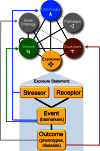The Comparative Toxicogenomics Database: update 2017
- PMID: 27651457
- PMCID: PMC5210612
- DOI: 10.1093/nar/gkw838
The Comparative Toxicogenomics Database: update 2017
Abstract
The Comparative Toxicogenomics Database (CTD; http://ctdbase.org/) provides information about interactions between chemicals and gene products, and their relationships to diseases. Core CTD content (chemical-gene, chemical-disease and gene-disease interactions manually curated from the literature) are integrated with each other as well as with select external datasets to generate expanded networks and predict novel associations. Today, core CTD includes more than 30.5 million toxicogenomic connections relating chemicals/drugs, genes/proteins, diseases, taxa, Gene Ontology (GO) annotations, pathways, and gene interaction modules. In this update, we report a 33% increase in our core data content since 2015, describe our new exposure module (that harmonizes exposure science information with core toxicogenomic data) and introduce a novel dataset of GO-disease inferences (that identify common molecular underpinnings for seemingly unrelated pathologies). These advancements centralize and contextualize real-world chemical exposures with molecular pathways to help scientists generate testable hypotheses in an effort to understand the etiology and mechanisms underlying environmentally influenced diseases.
© The Author(s) 2016. Published by Oxford University Press on behalf of Nucleic Acids Research.
Figures




Similar articles
-
Generating Gene Ontology-Disease Inferences to Explore Mechanisms of Human Disease at the Comparative Toxicogenomics Database.PLoS One. 2016 May 12;11(5):e0155530. doi: 10.1371/journal.pone.0155530. eCollection 2016. PLoS One. 2016. PMID: 27171405 Free PMC article.
-
The Comparative Toxicogenomics Database: update 2019.Nucleic Acids Res. 2019 Jan 8;47(D1):D948-D954. doi: 10.1093/nar/gky868. Nucleic Acids Res. 2019. PMID: 30247620 Free PMC article.
-
Comparative Toxicogenomics Database (CTD): update 2021.Nucleic Acids Res. 2021 Jan 8;49(D1):D1138-D1143. doi: 10.1093/nar/gkaa891. Nucleic Acids Res. 2021. PMID: 33068428 Free PMC article.
-
DiseaseMeth version 2.0: a major expansion and update of the human disease methylation database.Nucleic Acids Res. 2017 Jan 4;45(D1):D888-D895. doi: 10.1093/nar/gkw1123. Epub 2016 Nov 29. Nucleic Acids Res. 2017. PMID: 27899673 Free PMC article. Review.
-
The Comparative Toxicogenomics Database (CTD): a resource for comparative toxicological studies.J Exp Zool A Comp Exp Biol. 2006 Sep 1;305(9):689-92. doi: 10.1002/jez.a.307. J Exp Zool A Comp Exp Biol. 2006. PMID: 16902965 Free PMC article. Review.
Cited by
-
Bioinformatics Prediction for Network-Based Integrative Multi-Omics Expression Data Analysis in Hirschsprung Disease.Biomolecules. 2024 Jan 30;14(2):164. doi: 10.3390/biom14020164. Biomolecules. 2024. PMID: 38397401 Free PMC article.
-
Integrative transcriptomics analysis of lung epithelial cells and identification of repurposable drug candidates for COVID-19.Eur J Pharmacol. 2020 Nov 15;887:173594. doi: 10.1016/j.ejphar.2020.173594. Epub 2020 Sep 22. Eur J Pharmacol. 2020. PMID: 32971089 Free PMC article.
-
Snuba: Automating Weak Supervision to Label Training Data.Proceedings VLDB Endowment. 2018 Nov;12(3):223-236. doi: 10.14778/3291264.3291268. Proceedings VLDB Endowment. 2018. PMID: 31777681 Free PMC article.
-
In silico approaches in organ toxicity hazard assessment: current status and future needs in predicting liver toxicity.Comput Toxicol. 2021 Nov;20:100187. doi: 10.1016/j.comtox.2021.100187. Epub 2021 Sep 9. Comput Toxicol. 2021. PMID: 35340402 Free PMC article.
-
Identification of exosomal miR-455-5p and miR-1255a as therapeutic targets for breast cancer.Biosci Rep. 2020 Jan 31;40(1):BSR20190303. doi: 10.1042/BSR20190303. Biosci Rep. 2020. PMID: 31763681 Free PMC article.
References
Publication types
MeSH terms
Grants and funding
LinkOut - more resources
Full Text Sources
Other Literature Sources

